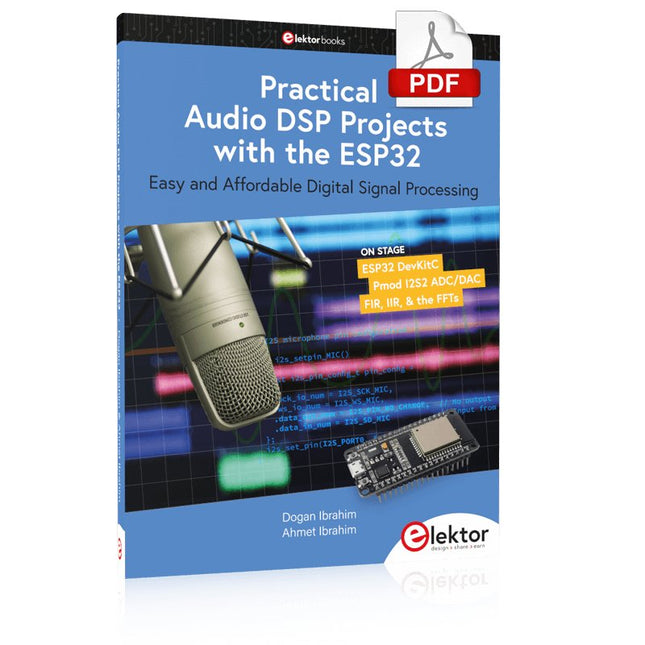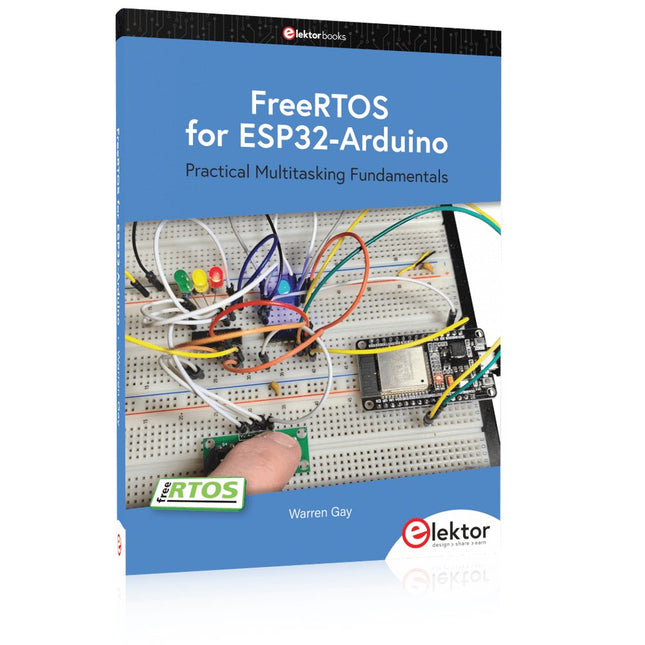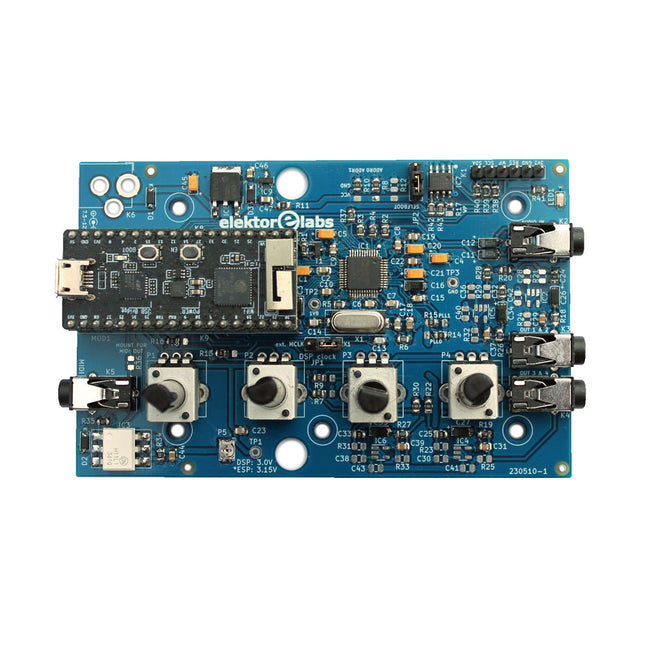Résultats de la recherche pour "ApplicationsDSP"
-

Ohmic Carte de développement PÚCA DSP ESP32
PÚCA DSP est une carte de développement ESP32 open source et compatible Arduino pour les applications audio et de traitement du signal numérique (DSP) avec des fonctionnalités de traitement audio étendues. Il fournit des entrées audio, des sorties audio, un réseau de microphones à faible bruit, une option de haut-parleur de test intégrée, une mémoire supplémentaire, une gestion de la charge de la batterie et une protection ESD, le tout sur un petit PCB compatible avec une maquette. Synthétiseurs, installations, interface utilisateur vocale et plus encore PÚCA DSP peut être utilisé pour une large gamme d'applications DSP, y compris, mais sans s'y limiter, celles dans les domaines de la musique, de l'art, de la technologie créative et de la technologie adaptative. Les exemples liés à la musique incluent la synthèse musicale numérique, l'enregistrement mobile, les haut-parleurs Bluetooth, les microphones directionnels sans fil au niveau de la ligne et la conception d'instruments de musique intelligents. Les exemples liés à l'art incluent les réseaux de capteurs acoustiques, les installations d'art sonore et les applications de radio Internet. Les exemples liés à la technologie créative et adaptative incluent la conception d'interfaces utilisateur vocales (VUI) et l'audio Web pour l'Internet des sons. Conception compacte et intégrée PÚCA DSP a été conçu pour la portabilité. Lorsqu'il est utilisé avec une batterie rechargeable externe de 3,7 V, il peut être déployé presque n'importe où ou intégré à presque n'importe quel appareil, instrument ou installation. Sa conception est le résultat de mois d'expérimentation avec diverses cartes de développement ESP32, cartes de dérivation DAC, cartes de dérivation ADC, cartes de dérivation microphone et cartes de dérivation de connecteur audio, et – malgré sa petite taille – il parvient à fournir toutes ces fonctionnalités en un seul. conseil. Et cela sans compromettre la qualité du signal. Caractéristiques Processeur et mémoire Processeur Espressif ESP32 Pico D4 Double cœur 32 bits 80 MHz / 160 MHz / 240 MHz 4 Mo SPI Flash avec 8 Mo de PSRAM supplémentaire (édition originale) Wi-Fi sans fil 2,4 GHz 802.11b/g/n BluetoothBLE 4.2 Antenne 3D l'audio Codec audio stéréo Wolfson WM8978 Entrée ligne audio sur connecteur stéréo 3,5 mm Audio Casque / Sortie Ligne sur connecteur stéréo 3,5 mm Entrée ligne auxiliaire stéréo, sortie audio mono acheminée vers l'en-tête GPIO 2x micros MEMS Knowles SPM0687LR5H-1 Protection ESD sur toutes les entrées et sorties audio Prise en charge des fréquences d'échantillonnage de 8, 11,025, 12, 16, 22,05, 24, 32, 44,1 et 48 kHz Pilote de haut-parleur 1 W, acheminé vers l'en-tête GPIO DAC SNR 98 dB, THD -84 dB (pondération « A » à 48 kHz) ADC SNR 95 dB, THD -84 dB (pondération « A » à 48 kHz) Impédance d'entrée ligne : 1 MOhm Impédance de sortie ligne : 33 Ohms Facteur de forme et connectivité Compatible avec la planche à pain 70x24mm 11x broches GPIO réparties sur un en-tête au pas de 2,54 mm, avec accès aux deux canaux ESP32 ADC, JTAG et broches tactiles capacitives USB 2.0 sur connecteur USB Type C Pouvoir Batterie rechargeable au lithium polymère 3,7/4,2 V, USB ou source d'alimentation externe 5 V CC L'ESP32 et le codec audio peuvent être placés en modes faible consommation sous contrôle logiciel Détection du niveau de tension de la batterie Protection ESD sur le bus de données USB Téléchargements GitHub Fiche de données Gauche Campagne de fourniture de masse (comprend une FAQ) Présentation du matériel Programmation du tableau Le codec audio
€ 69,95
Membres € 62,96
-

Elektor Publishing Practical Audio DSP Projects with the ESP32
Easy and Affordable Digital Signal Processing The aim of this book is to teach the basic principles of Digital Signal Processing (DSP) and to introduce it from a practical point of view using the bare minimum of mathematics. Only the basic level of discrete-time systems theory is given, sufficient to implement DSP applications in real time. The practical implementations are described in real time using the highly popular ESP32 DevKitC microcontroller development board. With the low cost and extremely popular ESP32 microcontroller, you should be able to design elementary DSP projects with sampling frequencies within the audio range. All programming is done using the popular Arduino IDE in conjunction with the C language compiler. After laying a solid foundation of DSP theory and pertinent discussions on the main DSP software tools on the market, the book presents the following audio-based sound and DSP projects: Using an I²S-based digital microphone to capture audio sound Using an I²S-based class-D audio amplifier and speaker Playing MP3 music stored on an SD card through an I²S-based amplifier and speaker Playing MP3 music files stored in ESP32 flash memory through an I²S-based amplifier and speaker Mono and stereo Internet radio with I²S-based amplifiers and speakers Text-to-speech output with an I²S-based amplifier and speaker Using the volume control in I²S-based amplifier and speaker systems A speaking event counter with an I²S-based amplifier and speaker An adjustable sinewave generator with I²S-based amplifier and speaker Using the Pmod I²S2 24-bit fast ADC/DAC module Digital low-pass and band-pass real-time FIR filter design with external and internal A/D and D/A conversion Digital low-pass and band-pass real-time IIR filter design with external and internal A/D and D/A conversion Fast Fourier Transforms (FFT)
€ 39,95
Membres € 35,96
-

Elektor Digital Practical Audio DSP Projects with the ESP32 (E-book)
Traitement du signal numérique simple et abordable Le but de cet ouvrage est d'enseigner les principes de base du Traitement Numérique du Signal (DSP) et de l'introduire d'un point de vue pratique en utilisant le strict minimum de mathématiques. Seul le niveau de base de la théorie des systèmes à temps discret est donné, suffisant pour implémenter des applications DSP en temps réel. Les implémentations pratiques sont décrites en temps réel à l'aide de la très populaire carte de développement de microcontrôleur ESP32 DevKitC. Avec le microcontrôleur ESP32, peu coûteux et extrêmement populaire, vous devriez être en mesure de concevoir des projets DSP élémentaires avec des fréquences d'échantillonnage comprises dans la plage audio. Toute la programmation est effectuée à l'aide du populaire IDE Arduino en conjonction avec le compilateur en langage C. Après avoir posé une base solide de la théorie DSP et des discussions pertinentes sur les principaux outils logiciels DSP du marché, le livre présente les projets audio et DSP suivants : Utilisation d'un microphone numérique basé sur I²S pour capturer le son audio Utilisation d'un amplificateur audio et d'un haut-parleur de classe D basés sur I²S Lecture de musique MP3 stockée sur une carte SD via un amplificateur et un haut-parleur basés sur I²S Lecture de fichiers de musique MP3 stockés dans la mémoire flash ESP32 via un amplificateur et un haut-parleur basés sur I²S Radio Internet mono et stéréo avec amplificateurs et haut-parleurs basés sur I²S Sortie de synthèse vocale avec un amplificateur et un haut-parleur basés sur I²S Utilisation du contrôle du volume dans les systèmes d'amplificateurs et de haut-parleurs basés sur I²S Un compteur d'événements parlants avec un amplificateur et un haut-parleur basés sur I²S Un générateur d'onde sinusoïdale réglable avec amplificateur et haut-parleur basés sur I²S Utilisation du module ADC/DAC rapide 24 bits Pmod I²S2 Conception de filtre FIR numérique passe-bas et passe-bande en temps réel avec conversion A/D et D/A externe et interne Conception de filtre IIR numérique passe-bas et passe-bande en temps réel avec conversion A/D et D/A externe et interne Transformations de Fourier rapides (FFT)
€ 32,95
Membres € 26,36
-

Elektor Digital FreeRTOS for ESP32-Arduino (E-book)
Practical Multitasking Fundamentals Programming embedded systems is difficult because of resource constraints and limited debugging facilities. Why develop your own Real-Time Operating System (RTOS) as well as your application when the proven FreeRTOS software is freely available? Why not start with a validated foundation? Every software developer knows that you must divide a difficult problem into smaller ones to conquer it. Using separate preemptive tasks and FreeRTOS communication mechanisms, a clean separation of functions is achieved within the entire application. This results in safe and maintainable designs. Practicing engineers and students alike can use this book and the ESP32 Arduino environment to wade into FreeRTOS concepts at a comfortable pace. The well-organized text enables you to master each concept before starting the next chapter. Practical breadboard experiments and schematics are included to bring the lessons home. Experience is the best teacher. Each chapter includes exercises to test your knowledge. The coverage of the FreeRTOS Application Programming Interface (API) is complete for the ESP32 Arduino environment. You can apply what you learn to other FreeRTOS environments, including Espressif’s ESP-IDF. The source code is available from GitHub. All of these resources put you in the driver’s seat when it is time to develop your next uber-cool ESP32 project. What you will learn: How preemptive scheduling works within FreeRTOS The Arduino startup “loopTask” Message queues FreeRTOS timers and the IDLE task The semaphore, mutex, and their differences The mailbox and its application Real-time task priorities and its effect Interrupt interaction and use with FreeRTOS Queue sets Notifying tasks with events Event groups Critical sections Task local storage The gatekeeper task
€ 34,95
Membres € 27,96
-

Elektor Publishing FreeRTOS for ESP32-Arduino
Practical Multitasking Fundamentals Programming embedded systems is difficult because of resource constraints and limited debugging facilities. Why develop your own Real-Time Operating System (RTOS) as well as your application when the proven FreeRTOS software is freely available? Why not start with a validated foundation? Every software developer knows that you must divide a difficult problem into smaller ones to conquer it. Using separate preemptive tasks and FreeRTOS communication mechanisms, a clean separation of functions is achieved within the entire application. This results in safe and maintainable designs. Practicing engineers and students alike can use this book and the ESP32 Arduino environment to wade into FreeRTOS concepts at a comfortable pace. The well-organized text enables you to master each concept before starting the next chapter. Practical breadboard experiments and schematics are included to bring the lessons home. Experience is the best teacher. Each chapter includes exercises to test your knowledge. The coverage of the FreeRTOS Application Programming Interface (API) is complete for the ESP32 Arduino environment. You can apply what you learn to other FreeRTOS environments, including Espressif’s ESP-IDF. The source code is available from GitHub. All of these resources put you in the driver’s seat when it is time to develop your next uber-cool ESP32 project. What you will learn: How preemptive scheduling works within FreeRTOS The Arduino startup “loopTask” Message queues FreeRTOS timers and the IDLE task The semaphore, mutex, and their differences The mailbox and its application Real-time task priorities and its effect Interrupt interaction and use with FreeRTOS Queue sets Notifying tasks with events Event groups Critical sections Task local storage The gatekeeper task
€ 44,95
Membres € 40,46
-

Elektor Digital ESP8266 and MicroPython (E-book)
Recently, the development of a tiny chip called the ESP8266 has made it possible to interface any type of microcontroller to a Wi-Fi AP. The ESP8266 is a low-cost tiny Wi-Fi chip having fully built-in TCP/IP stack and a 32-bit microcontroller unit. This chip, produced by Shanghai based Chinese manufacturer Espressif System, is IEEE 802.11 b/g/n Wi-Fi compatible with on-chip program and data memory, and general purpose input-output ports. Several manufacturers have incorporated the ESP8266 chip in their hardware products (e.g. ESP-xx, NodeMCU etc) and offer these products as a means of connecting a microcontroller system such as the Android, PIC microcontroller or others to a Wi-Fi. The ESP8266 is a low-power chip and costs only a few Dollars. ESP8266 and MicroPython – Coding Cool Stuff is an introduction to the ESP8266 chip and describes the features of this chip and shows how various firmware and programming languages such as the MicroPython can be uploaded to the chip. The main aim of the book is to teach the readers how to use the MicroPython programming language on ESP8266 based hardware, especially on the NodeMCU. Several interesting and useful projects are given in the e-book (pdf) to show how to use the MicroPython in NodeMCU type ESP8266 hardware: Project “What shall I wear today?”: You will be developing a weather information system using a NodeMCU development board together with a Text-to-Speech processor module. Project “The Temperature and Humidity on the Cloud”: You will be developing a system that will get the ambient temperature and humidity using a sensor and then store this data on the cloud so that it can be accessed from anywhere. Project “Remote Web Based Control”: You will be developing a system that will remotely control two LEDs connected to a NodeMCU development board using an HTTP Web Server application.
€ 29,95
Membres € 23,96
-

Elektor Labs Elektor Audio DSP FX Processor (Nouvelle Révision)
Le Elektor Audio DSP FX Processor combine un microcontrôleur ESP32 et un DSP Audio ADAU1701 d'Analog Devices. Outre un noyau DSP programmable par l'utilisateur, l'ADAU1701 intègre des convertisseurs analogique-numérique et numérique-analogique de haute qualité et dispose d'un port I²S. Cela le rend approprié comme interface audio de haute qualité pour l'ESP32. Les programmes pour l'ESP32 peuvent être créés avec Arduino, Platform IO, CMake ou en utilisant Espressif IDF d'une autre manière. Les programmes pour les DSP audio ADAU7101 sont créés avec l'outil de programmation visuelle gratuit SigmaStudio en glissant et déposant des blocs d'algorithmes prédéfinis sur un canevas. Applications Sink audio Bluetooth/Wi-Fi (par ex. haut-parleur) et source Pédale d'effet guitare (stomp box) Synthétiseur musical Générateur de sons/fonctions Filtre cross-over programmable pour haut-parleurs Processeur d'effets audio avancé (réverbération, chorus, pitch shifting, etc.) Appareil audio connecté à Internet Plate-forme d'expérimentation DSP MIDI sans fil Convertisseur MIDI vers CV et bien d'autres... Spécifications Processeur audio numérique ADAU1701 28/56 bits, 50 MIPS prenant en charge des taux d'échantillonnage allant jusqu'à 192 kHz Microcontrôleur double cœur ESP32 32 bits avec Wi-Fi 802.11b/g/n et Bluetooth 4.2 BR/EDR et BLE 2 entrées audio 24 bits (2 V RMS, 20 kΩ) 4 sorties audio 24 bits (0,9 V RMS, 600 Ω) 4x potentiomètres de contrôle Entrée et sortie MIDI Port d'extension I²C Fonctionnement multimode Alimentation : USB 5 V CC ou 7,5-12 V CC (prise cylindrique, broche centrale GND) Consommation de courant (moyenne) : 200 mA Inclus 1x Carte Audio DSP FX Processor (assemblée) 1x ESP32-PICO-KIT 2x Cavaliers 2x Connecteurs à 18 broches (female) 4x Potentiomètres de 10 Ko Téléchargements Documentation GitHub
€ 99,95€ 84,95
Membres identique
-

Elektor Digital MicroPython for Microcontrollers (E-book)
Projets avec Thonny-IDE, uPyCraft-IDE et ESP32 Le langage de programmation « Python » a connu un énorme essor ces dernières années. Enfin, divers systèmes monocarte tels que le Raspberry Pi ont contribué à sa popularité. Mais Python a également été largement utilisé dans d’autres domaines, comme l’intelligence artificielle (IA) ou l’apprentissage automatique (ML). Il est donc évident d'utiliser également Python ou la variante « MicroPython » pour une utilisation dans les SoC (Systems on Chip). Des contrôleurs puissants tels que l'ESP32 d'Espressif Systems offrent d'excellentes performances ainsi que des fonctionnalités Wi-Fi et Bluetooth à un prix abordable. Avec ces fonctionnalités, la scène Maker a été prise d’assaut. Comparé à d'autres contrôleurs, l'ESP32 dispose d'une mémoire Flash et SRAM nettement plus grande, ainsi que d'une vitesse de processeur beaucoup plus élevée. Grâce à ces caractéristiques, la puce convient non seulement aux applications C classiques, mais également à la programmation avec MicroPython. Ce livre présente l'application des systèmes modernes à puce unique. En plus du contexte technique, l'accent est mis sur MicroPython lui-même. Après l’initiation au langage, les compétences en programmation acquises sont immédiatement mises en pratique. Les projets individuels conviennent aussi bien à une utilisation en laboratoire qu'à des applications quotidiennes. Ainsi, outre l’effet d’apprentissage réel, l’accent est également mis sur le plaisir de construire des appareils complets et utiles. En utilisant des planches à pain de laboratoire, des circuits de toutes sortes peuvent être réalisés avec peu d'effort, transformant les tests et le débogage des projets 100 % homebrew en un plaisir instructif. Les différentes applications, telles que les stations météorologiques, les voltmètres numériques, les télémètres à ultrasons, les lecteurs de cartes RFID ou les générateurs de fonctions, rendent les projets présentés parfaitement adaptés aux cours pratiques ou aux travaux de matières et d'études en sciences naturelles ou aux cours de sciences et technologies.
€ 32,95
Membres € 26,36







